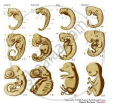Advertisements
Advertisements
प्रश्न
Enlist the evidences of evolution.
उत्तर
Following are the evidences of evolution:
- Morphological evidences
- Anatomical evidences
- Vestigial organs
- Palaeontological evidences
- Connecting links
- Embryological evidences
APPEARS IN
संबंधित प्रश्न
State the connecting links between Peripatus with Annelida and Arthopoda.
Give two examples of vestigial organs in human beings and plants.
Given below is the list of vegetables available in the market. Select from these the two vegetables having homologous structures:
Potato, sweet potato, ginger, radish, tomato, carrot, okra (Lady’s finger)
(A) Potato and sweet potato
(B) Radish and carrot
(C) Okra and sweet potato
(D) Potato and tomato
Which of the following pairs of two vegetables represent the correct homologous structures?
(A) Sweet potato and potato
(B) Sweet potato and tomato
(C) Carrot and potato
(D) Radish and carrot
With the help of any two suitable examples explain the effect of anthropogenic actions on organic evolution.
Enlist any four sequential evolutionary names of human ancestors.
Explain with an example for the given, how the following provides evidence in favor of evolution in organisms :
Analogous organs
Explain with an example for the given, how the following provides evidence in favor of evolution in organisms :
Fossils
Explain the evolution of giraffe's neck according to Lamarck's theory of evolution.
Name any two temporary embryonic structures in vertebrates which provide evidence for evolution.
Human tailbone is a vestigial organ. Explain.
The presence of which of the following types of organs in two organisms indicates that they are derived from the same ancestor?
(a) analogous organs
(b) respiratory organs
(c) digestive organs
(d) homologous organs
The wings of a housefly and the wings of a sparrow are an example of :
(a) analogous organs
(b) vestigial organs
(c) respiratory organs
(d) homologous organs
What do we call the degenerated or partially developed useless organs in living organisms? Enlist such organs in human body? How the same organs are useful in other animals?
Write the names of those animals in whom the human body organs are functioning.
Observe the picture and answer the following questions.
A) Which evidence of evolution is shown in the picture?
B) What can be proven with this proof?
C) Give one more example of evidence of evolution
“Appearance of melanised moths post-industrialisation in England is a classic example of evolution by natural selection.” Explain.
Draw a labelled diagram of T.S. of a leaf showing Kranz anatomy.
What do you mean by vestigial structures? Name four vestigial organs found in man.
Explain any three molecular (genetic) evidences in favour of organic evolution.
Define phylogeny.
Name the parts shown in the diagram.
Human jaw

The decaying process of C-14 occurs continuously in dead organisms only.
Match the following.
| Column A | Column B |
| 1) Morphological evidences | a) Tail-bone or wisdom teeth |
| 2) Paleontological evidences | b) Leaf venation |
| c) Fossils |
Observe the given images and answer the following questions.

- Which evolutionary evidence does it indicate?
- What does it prove?
- State another example of evolutionary evidence.
Biogenetic law states that ______.
Select the CORRECT match.
Tendons and ligaments are examples of ______.
Basic principles of embryonic development were pronounced by:
The process of mating of individuals, which are more closing related than the average of the population to which they belong is called ______.
The study of fossil evidence of evolution is called ______
Which of the following is used as an atmospheric pollution indicator?
Appearance of antibiotic-resistant bacteria is an example of ______.
Did aquatic life forms get fossilised? If, yes where do we come across such fossils?
Complete the following chart:

Write avian characters of Archaeopteryx.
Give examples of homologous organs and analogous organs in plants.
